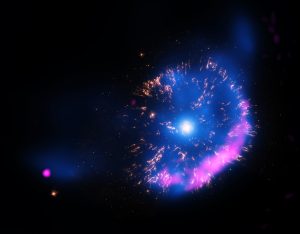
Earth’s night sky could have a “new” star blaze into the firmament over the next few months—despite humans having already seen this star a number of times throughout our history—in the form of what is known as a recurrent nova.
Located between Hercules and Boötes, this recurrent stellar nova will appear sometime between now and September in the constellation of Corona Borealis—the Northern Crown. This celestial explosion is expected to originate in T Coronae Borealis, or T CrB, a binary system a little over 2,600 light years away; typically, T CrB only has an apparent magnitude of 10, meaning one would typically need ordinary binoculars just to see it, but the star system has already given signs that it may be preparing to flare into view sometime soon.
Recurrent novae are, as the name implies, novae that are generated from a star more than once, with a number of the star systems known to produce these cosmic-level explosions doing so at a regular rate. T CrB is one of those regularly-erupting novae with a period of roughly 80 years, having been observed to flare up in 1217, 1787, 1866 and 1946.
One of the signs that a recurrent nova is about to occur is a steady increase in the star’s brightness, followed by a period of dimming, something that T CrB started doing in February 2015. The last time this increase in magnitude was observed was 1938, followed by a pronounced nova in 1946; if the pattern holds, T CrB could erupt within the next few months.
The few recurrent novae that are known—there are only ten within our galaxy—occur in systems that are home to two stars, or more appropriately a stellar remnant called a white dwarf, and either a regular, sun-like star or an older red giant. Both bodies are locked in an orbit close enough to one-another for the white dwarf to be able to draw material from the atmosphere of the active, typically younger star, with that material pooling on the dwarf’s surface, building up in ever-deepening layers as time progresses.
Being the leftover core of a star that has long since sloughed off its outer layers, a white dwarf possesses a sun-like mass compacted down into a sphere the size of an Earth-like planet, making the object unfathomably dense: a chunk of white dwarf the size of a sugar cube would weigh more than one ton. Although its gravitational pull falls well short of that of a black hole, this extreme density produces a gravitational field hundreds of thousands of times that of Earth’s.
After enough material from the dwarf’s companion star builds up on its surface, the crushing gravity causes enough heat and pressure to build up in the material for it to undergo nuclear fusion, with the energy released building up until the entire surface of the white dwarf erupts in a stellar nova.
Subscribers, to watch the subscriber version of the video, first log in then click on Dreamland Subscriber-Only Video Podcast link.